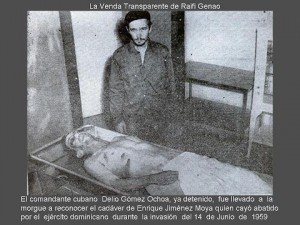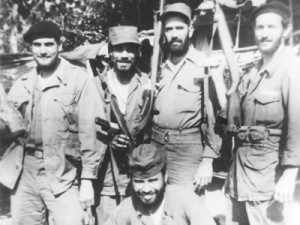Testimony of former guerrillas in the Cuba’s Escambray Mountains Roger Redondo.
“Five kilometers from the city of Trinidad en route to the city of Cienfuegos, just several hundred meters of the road, was the estate of Thomas Serquera. One day I came in the afternoon in the company of Hector Rodriguez. Thomas introduced us to two men who that day had come to join our band of rebels. Both were foreigners, the Venezuelan was younger, I forget his name.
The other was Fort Henry Anton, an Algerian. I began to ask why they wanted to participate in our struggle and through whom had managed to get there.

Left to Right: Mario Marín, Eloy Gutiérrez Menoyo, Henry Fuerte (el Argelino) y William Morgan, de rodillas José Arcadio García.
They told me they had arrived in Cuba on a ship from Venezuela, who always arrived at the port of Casilda to load tiles pansies, but they did not know anyone in that city.
Serquera Thomas told me that some friends of Piro Guinart had taken to his house. But no one could find some strangers in the street without knowing, he would have brought him there, so would have to stay with us until we could find out more about them.
Shortly after we learned that Venezuela was the only child of a woman left politics of his country, where land and sea moved out of danger. Those efforts were made by our people of the city of Santa Clara. The young man returned to Venezuela by the entreaties of his mother.
The Algerian had military training, but nobody knew him, he only knew what he was telling himself, but I had no way to verify if it was true. Spoke Spanish as their mother tongue, French and Arabic. According to him, had been a soldier of the French army, guerrillas in Algeria, merchant seaman and later lived in Haiti.
He aspired to when the fight ended in Cuba, an expedition to defeat the Haitian dictatorship of Duvalier.
Camus was given the responsibility of training in handling weapons and military discipline of several hundred unarmed rebel soldiers in a place called The Horn. I really had great knowledge in the management of arms.
That rustic troop crank telephones installed, through several miles, repaired roads and built trenches.
On January 1959, the Algerian, moved away from the sight of men of the Second Front of Escambray, and maintaining a discreet relationship with Che Guevara. On August 14, 1959, escorted by the frigate landed Maximo Gomez on the coast of Haiti, a place called Les Irois, leading an expedition made up of 33 men: Cubans, Haitians and Venezuelans. On August 20, fell into an ambush that killed most of them. A few were taken prisoners and several were shot. That was the end of the Algerian. They are defeated by the Haitian Army, with the aid of US marines.
So where I have understood, this group was the last after three expeditions to the Dominican Republic.
If it had succeeded in creating a guerrilla resistance in Haiti, Trujillo had been forced to deploy troops in the Haitian border. Therefore the Goat could not use them in the repression in the rest the country.
The expedition to Haiti was part of the same military operation against the regime of the Dominican Republic.
Exactly two months earlier, on June 14, Dominican Delio Jiménez Moya and Ochoa Gomez, commander of the rebel army to the Spanish arrived in a transport plane. Surprise landed in the airfield of Constance had very little defense, leading 54 men. There was a landing with a hundred men in mid-July in Maimon, while in Estero Hondo landed another 50 men.
Combined forces of the aviation, marine and the Dominican army, plus several hundred European mercenaries and soldiers, who were a force designed for an immediate attack on the Cuban revolution, took part in the operations of persecution and destruction of the revolutionary guerrillas against Leonidas Trujillo.
Venezuela’s president Romulo Betancourt funded much of the costs of all these expeditions. While former President Carlos Andres Perez, was monitoring these activities in Cuba under the name of Santiago.
In retaliation, Trujillo’s men managed to put an explosive charge in the streets of Caracas, which exploded by remote control, causing injuries to both hands to President Betancourt.
From the first of January 1959 to July 1961, several political changes occurred in the Caribbean. So surreal Trujillo turned left by legalizing the Popular Socialist Party (PSP), which bore the same name as the Cuban Communist Party. It also allowed the return of exiled Dominicans of the Communist Party who were in Cuba. In those days the U.S. government pressured Trujillo to facilitate the democratization of the Dominican Republic. The Goat, a man of confidence of the U.S.A. became his enemy. At the same time Juan Domingo Perón established relations with his fellow Ernesto (Che) Guevara de la Serna.
In Havana on March 14, 1961 were executed at La Cabaña, the commanders of the Second Front of Escambray William Morgan and Jesus Carrera. On May 30, 1961 Trujillo died due to an attack. On June 9, 1961 Delio Gomez Ochoa was released, leaving the history of the Caribbean black hole, difficult to understand.
CartasaOfelia/FelixHernandez/RogerRedondo/
InternetPhotos/www.TheCubanHistory.com
Attempts of Cuban Guerrillas against Trujillo and Duvalier
The Cuban History,Hollywood.
Arnoldo Varona, Editor
Foto por Uriel Semper with Odalys Wilson. – Bahia de la Habana, Castillo del Morro.

INTENTOS GUERRILLEROS DESDE CUBA CONTRA TRUJILLO Y DUVALIER
Testimonios del ex guerrillero del Escambray Roger Redondo.
“A cinco kilómetros de la ciudad de Trinidad con rumbo a la ciudad de Cienfuegos, a sólo varios cientos de metros de la carretera, se encontraba la finca de Tomás Serquera. Un día llegué por la tarde en compañía de Héctor Rodríguez. Tomás nos presentó a dos hombres que ese mismo día habían llegado para incorporarse a nuestra tropa de rebeldes. Ambos eran extranjeros, el más joven era venezolano, no recuerdo su nombre.
El otro era Henry Fuerte de Antón, ciudadano argelino. Comencé a preguntarles por qué querían participar en nuestra lucha y por medio de quién habían conseguido llegar hasta allí.

De izquierda a derecha: Mario Marín, Eloy Gutiérrez Menoyo, Henry Fuerte (el Argelino) y William Morgan, de rodillas José Arcadio García.
Me contaron que habían llegado a Cuba en un barco desde Venezuela, que siempre llegaba al puerto de Casilda para cargar tejas trinitarias, pero que ellos no conocían a nadie en aquella ciudad.
Tomás Serquera me contó que unos amigos de Piro Guinart los había llevado hasta su casa. Pero nadie que encontrara a unos extranjeros en la calle sin conocerlos, los hubiera llevado hasta allí, por lo tanto tendrían que quedarse con nosotros hasta que lográramos investigar más sobre ellos.
Poco después supimos que el venezolano era hijo único de una mujer política de izquierda de su país, la cual movilizó mar y tierra para sacarlo del peligro. Esas gestiones se realizaron a través de gente nuestra de la ciudad de Santa Clara. El joven regresó a Venezuela por los ruegos de su madre.
El Argelino tenía entrenamiento militar, pero nadie lo conocía, sólo se sabía de él lo que contaba de sí mismo, pero yo no tenía forma de verificar si era cierto. Hablaba el español como si fuera su lengua materna, el francés y el árabe. Según él, había sido soldado del ejército francés, guerrillero en Argelia, marino mercante y posteriormente había vivido en Haití.
Aspiraba a que cuando terminara la lucha en Cuba, organizar una expedición para derrotar a la dictadura haitiana de Duvalier.
Se le dio al argelino la responsabilidad de entrenar en el manejo de las armas y en la disciplina militar a varios cientos de soldados rebeldes desarmados, en un lugar llamado Los Hornos. Realmente tenía grandes conocimientos en el manejo de las armas.
Aquella tropa instalaba teléfonos rústicos de maniguetas, a través de varios kilómetros, reparaba caminos y construía trincheras.
El primero de enero de 1959, El Argelino, se alejó de la vista de los hombres del Segundo Frente del Escambray, ya que mantenía una discreta relación con el Ché Guevara. El 14 de agosto de 1959 desembarcó escoltado por la fragata Máximo Gómez en la costa de Haití, por un lugar de nombre Les Irois, al frente de una expedición compuesta por 33 hombres: cubanos haitianos y venezolanos. El 20 de agosto cayeron en una emboscada donde murieron la mayor parte de ellos. Unos pocos fueron tomados prisioneros y varios fueron fusilados. Ese fue el final de El Argelino.
Hasta donde yo tengo entendido, este grupo fue el último después de las tres expediciones a la República Dominicana.
Si se hubiera tenido éxito en crear en Haití una resistencia guerrillera, Trujillo se hubiera visto obligado a desplegar efectivos militares en la frontera haitiana. Por lo cual El Chivo no hubiera podido utilizarlas en la represión en el resto el país.
La expedición a Haití formó parte de la misma operación militar contra el régimen de la República Dominicana.
Exactamente dos meses antes, el 14 de junio, el dominicano Jiménez Moya y Delio Gómez Ochoa, comandante del Ejército Rebelde llegaron a la Española en un avión de transporte. Aterrizaron por sorpresa en la pista aérea de Constanza que contaba con muy poca defensa, al frente de 54 hombres. Hubo un desembarco con cien hombres a mediados de julio en Maimón, mientras que en Estero Hondo desembarcaron otros 50 hombres.
Fuerzas combinadas de la aviación, la marina y el ejército dominicano, más varios cientos de mercenarios y militares europeos, que formaban una fuerza destinada para un inmediato ataque contra la revolución cubana, tomaron parte en las operaciones de persecución y destrucción de las guerrillas revolucionarias contra Leonidas Trujillo.
El presidente de Venezuela Rómulo Betancourt financió gran parte de los costos de todas esas expediciones. Mientras que el ex presidente Carlos Andrés Pérez, se encontraba en Cuba supervisando esas actividades bajo el pseudónimo de Santiago.
Como represalia, los hombres de Trujillo lograron poner una carga explosiva en una calle de Caracas, que estalló por control remoto, lo que provocó heridas en ambas manos al presidente Betancourt.
Del primero de enero de 1959 hasta julio del 1961, sucedieron varios cambios políticos en el Caribe. Trujillo de forma surrealista giró hacia la izquierda al legalizar el Partido Socialista Popular (P.S.P.), el cual llevaba el mismo nombre que el Partido Comunista Cubano. También permitió el regreso de los exiliados dominicanos del Partido Comunista que se encontraban en Cuba. En aquellos días el gobierno de los Estados Unidos presionaba a Trujillo para que facilitara la democratización de la República Dominicana. El Chivo, de hombre de confianza de los U.S.A. pasó a ser su enemigo. Al mismo tiempo Juan Domingo Perón estableció relaciones con su paisano Ernesto (Ché) Guevara de la Serna.
En La Habana el 14 de marzo de 1961 fueron fusilados en La Cabaña, los comandantes del Segundo Frente del Escambray William Morgan y Jesús Carrera. El 30 de mayo de 1961 murió Trujillo debido a un atentado. El día 9 de junio de 1961 Delio Gómez Ochoa fue liberado, dejando en la historia del Caribe un agujero negro, difícil de comprender”.
CartasaOfelia/FelixHernandez/RogerRedondo/
InternetPhotos/www.TheCubanHistory.com
Attempts of Cuban Guerrillas against Trujillo and Duvalier
The Cuban History,Hollywood.
Arnoldo Varona,






